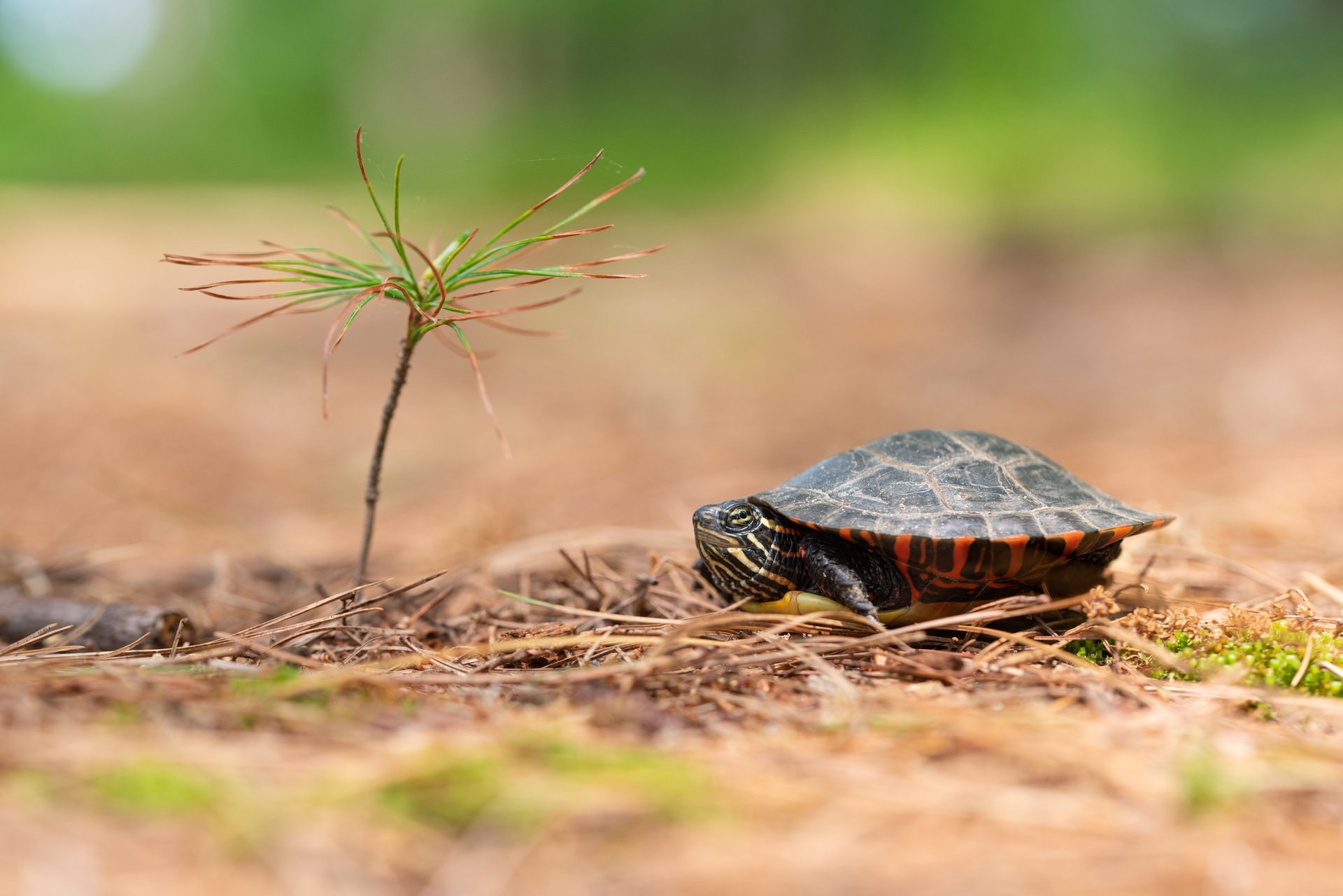Turtles
Turtles are reptiles, like snakes and lizards, but they’re more ancient than either of those groups. The first turtles appeared over 200 million years ago. Although many turtle species live in the water, all must breathe air and lay eggs on land.
Identification
All turtles have shells. Because these shells are made of modified bones like ribs, turtles can’t crawl out of them. The shell covering a turtle's body consists of a top part called the carapace, a bottom part called the plastron, and connecting parts called bridges.
Turtles have no teeth. Instead, their jaws are hard and bony with sharp edges.
Types of Turtles Found in Massachusetts
There are 10 species of turtles in Massachusetts. They range from the tiny bog turtle, which measures 3-4” long, to the snapping turtle, which can reach up to 19” long. In addition, five sea turtles have also been found offshore, or stranded on beaches.
If you come across any turtles listed under the Massachusetts Endangered Species Act, it should be photographed to confirm the identification and the Natural Heritage and Endangered Species Program should be notified.
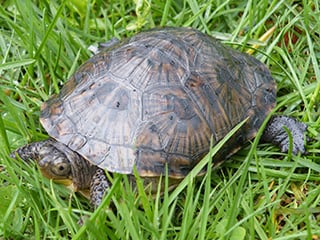
Blanding’s Turtle (Emydoidea blandingii)
Found in the eastern half of the state, it has a dark body and a bright yellow throat and grows up to 9” long. It inhabits a variety of habitat types, and eats both plants, such as duckweed and sedges, and animals, such as fish and snails. Status: Threatened under the Massachusetts Endangered Species Act. It’s illegal to kill, harass, collect, or possess this turtle.
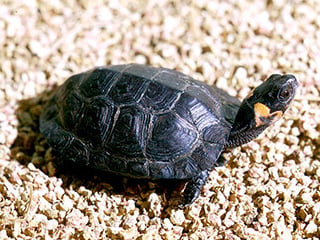
Bog Turtle (Glyptemys muhlenbergii)
The rarest turtle in the state, the bog turtle is under threat from habitat loss and collection for the pet trade. It’s tiny, just 3-4” long, with a bright yellow spot on either side of its head. True to its name, it lives in bogs and other wetlands. It mostly eats invertebrates such as slugs and insect larvae. Status: Endangered under the Massachusetts Endangered Species Act and federally Threatened. It’s illegal to kill, harass, collect, or possess this turtle.
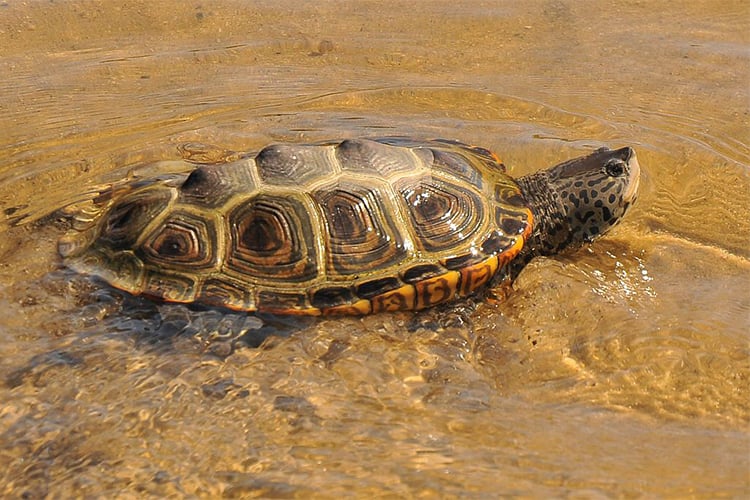
Diamond-backed Terrapin (Malaclemys terrapin)
A coastal species inhabiting estuaries and mud flats, the diamond-backed terrapin grows up to 9” long, and eats snails, small crustaceans, worms, and some aquatic plants. In order to survive in salty environments, it excretes excess salt through orbital (eye) glands. Status: Threatened under the Massachusetts Endangered Species Act. It’s illegal to kill, harass, collect, or possess this turtle.
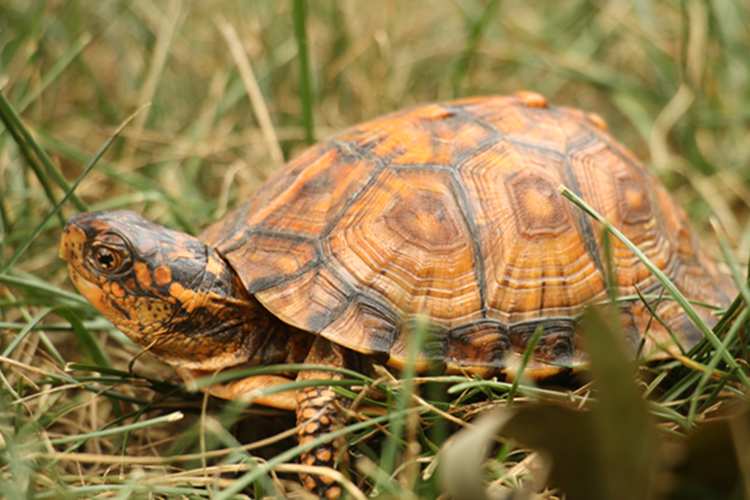
Eastern Box Turtle (Terrapene carolina)
Terrestrial, wandering forest floors, fields, marsh edges, and many other habitats, the eastern box turtle is primarily found in the warmer parts of the state. It eats many plant and small animal species. In the late afternoon, it builds a domelike structure from grasses or leaves—called a form—in which to spend the night. Status: A Species of Special Concern under the Massachusetts Endangered Species Act. It’s illegal to kill, harass, collect, or possess this turtle.
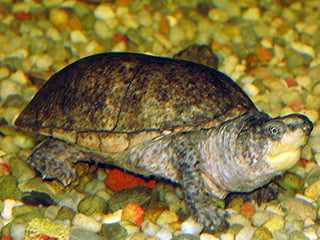
Eastern Musk Turtle (Sternotherus odoratus)
A denizen of slow-moving water, the eastern musk turtle rarely basks and only leaves the water to lay eggs. Its diet includes mollusks, tadpoles, and aquatic insects and plants. It has a pointy face and a high-domed shell and is also known as a stinkpot—when startled, it will emit an unpleasant odor.
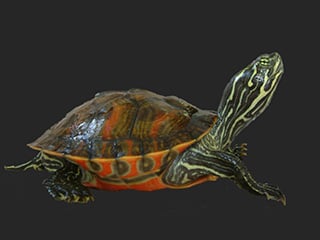
Northern Red-bellied Cooter (Pseudemys rubirentris)
It’s only found in one county in Massachusetts: Plymouth County. This large turtle (up to 12” long) looks somewhat like a painted turtle but lacks the two yellow markings behind the eyes. The plastron (lower shell) is pink in males and red in females. It prefers freshwater ponds with basking sites and aquatic vegetation, and mostly eats plants, but may occasionally consume meat, such as fish or tadpoles. Status: Endangered federally and under the Massachusetts Endangered Species Act. It’s illegal to kill, harass, collect, or possess this turtle.
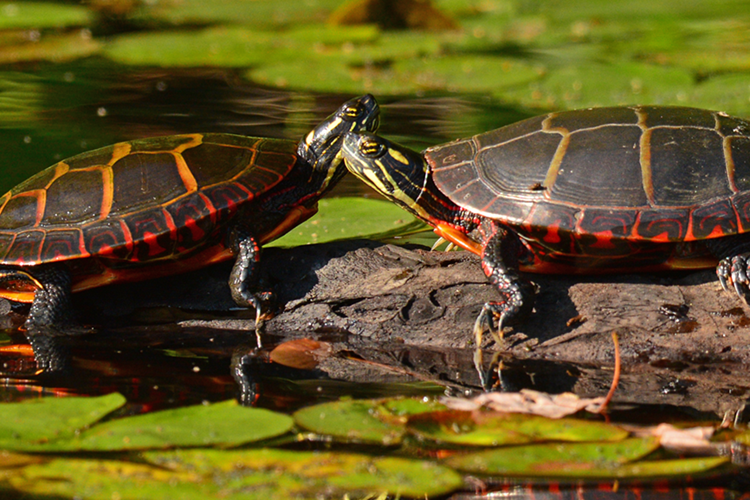
Painted Turtle (Chrysemys picta)
It’s common throughout the state in shallow bodies of water that offer places to bask. In fact, it can spend as many as six hours a day basking in the sun! It grows up to 8” long. It has a smooth olive shell and yellow stripes on its head, with two distinctive yellow spots behind each eye. Its diet is varied and includes aquatic plants, small fish, and snails.
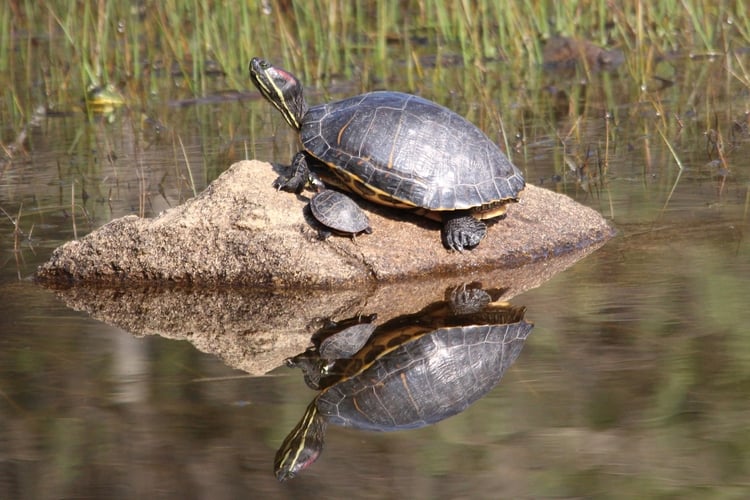
Red-eared Slider (Trachemys scripta elegans)
Native to the southeastern US, this invasive species has been popular in the pet trade, and the offspring of released pets can be found all across Massachusetts—and in many parts of the world. The red-eared slider looks much like a painted turtle but has two red marks (the “ears”) behind its head, a higher domed carapace, and a more rounded jaw. It inhabits ponds, lakes, and slow-moving streams.
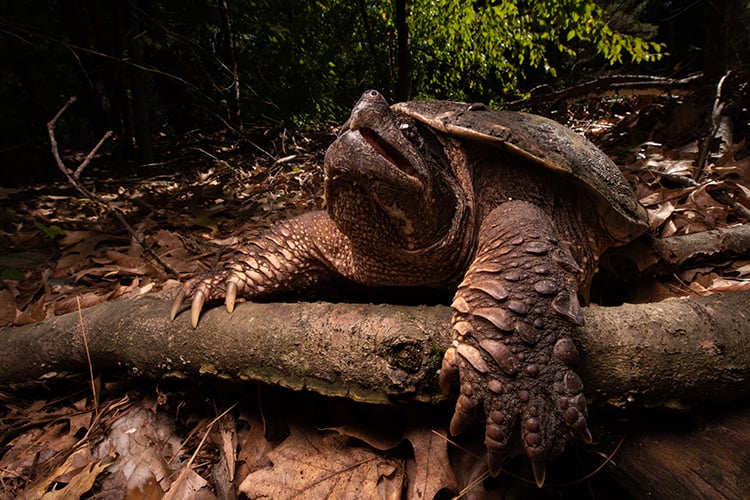
Snapping Turtle (Chelydra serpentina)
Found in all sorts of water bodies, from rivers to lakes to marshes, the snapping turtle can grow up to 19” long. It has three ridges on its carapace, as well as a spiky tail. It eats many different plants and animals and becomes more vegetarian as it ages. Snapping turtles can be aggressive and deliver a painful bite if threatened, possibly because their small lower shell (plastron) leaves them vulnerable. Give them plenty of space and be aware that their neck can stretch the length of the shell. Never grab one by the tail—you could seriously injure the turtle.
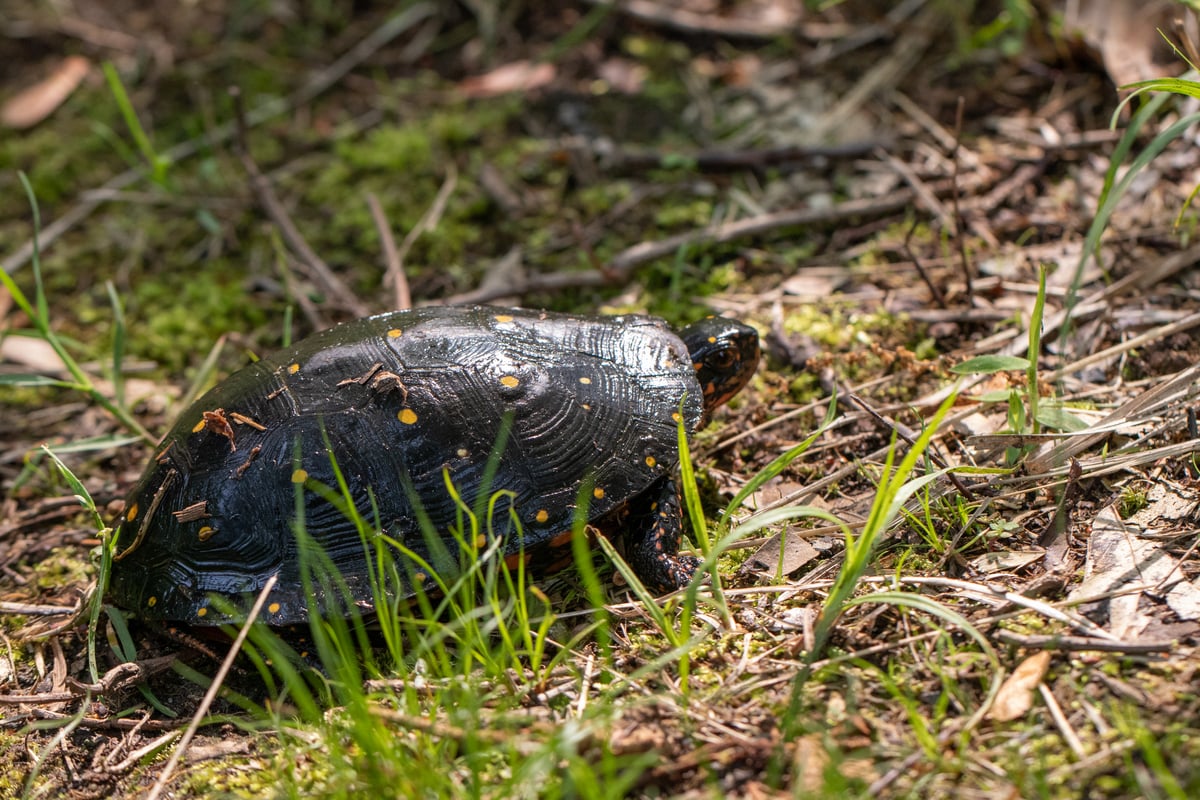
Spotted Turtle (Clemmys guttata)
Small, the spotted turtle only grows up to 4.5” long. It has a smooth dark shell with little yellow polka dots. It lives in wet meadows, marshes, bogs, small ponds, and slow-moving streams. It mostly eats animals, such as worms and frogs, but will occasionally eat plants.
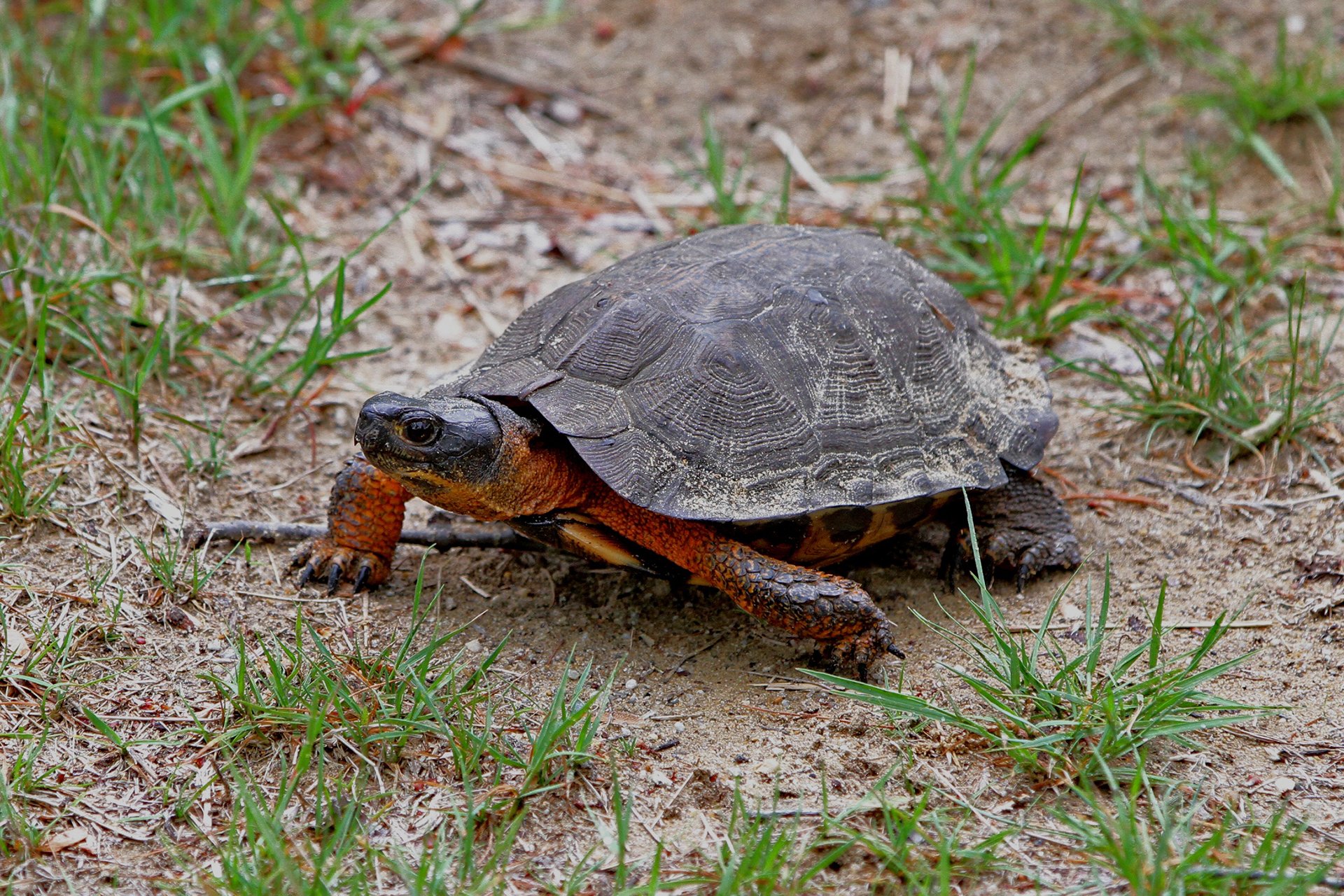
Wood Turtle (Clemmys insculpta)
The Wood Turtle spends most of its time on land. It feeds both on land and in the water, eating animals such as insects and earthworms, and plant foods such as algae and grass. It grows up to 8” long. It has a shell that resembles carved wood, and its neck and part of its legs are bright orange. Status: A Species of Special Concern under the Massachusetts Endangered Species Act. It’s illegal to kill, harass, collect, or possess this turtle.
Sea Turtles Found on Cape Cod
Most adult sea turtles are truly tropical or sub-tropical creatures. Yet certain species of juvenile sea turtles come north to feed along the East Coast and return south before the onset of winter. While highly unlikely, it is possible, with luck, to find four species of sea turtles in Cape Cod waters.
All four species are listed as either "Threatened" or "Endangered" under both the U.S. Endangered Species Act (ESA) and the Massachusetts Endangered Species Act (MESA). This means it's illegal to harass them, and you cannot transport them without a permit.
Sea turtle staff at Wellfleet Bay are the federally mandated responders to all sea turtle strandings in southeastern Massachusetts. Staff conduct year-round sea turtle work under a US Fish & Wildlife Service permit, which is jointly administered by the National Oceanic and Atmospheric Administration. Learn more about our sea turtle rescue work
Kemp's Ridley (Lepidochelys kempii)
Status: Critically Endangered
The smallest and most endangered sea turtle in the world, the Kemp's Ridley is also the most common turtle found cold-stunned on Massachusetts bayside beaches. Juveniles in our waters are typically only three to ten pounds, but adults can grow up to 100 pounds further south. Several hundred to a thousand juveniles typically become cold-stunned and strand each winter on Cape Cod.
Loggerhead (Caretta caretta)
Status: Threatened
Loggerheads have the largest geographic distribution of any sea turtle in the world. Juveniles and subadults in our waters can vary widely in size—between five and 200 pounds —and full-grown adults average 260 pounds. Loggerheads are becoming a commonly stranded species on Cape Cod. In recent years, an average of 25 are found cold-stunned, with a high of nearly 150 in 2012.
Green (Chelonia mydas)
Status: Threatened
Named for the green color of their body fat, Green turtles are growing increasingly threatened. Like Loggerheads, juvenile Greens have been stranding on Cape Cod beaches in increasing numbers during the late fall/ early winter months—up to a few dozen per year in the past few years. Juveniles in our waters can weigh anywhere from three to 20 pounds, and adults average 310 pounds.
Leatherback (Dermochelys coriacea)
Status: Endangered
Leatherbacks are the largest turtle species in the world. Through both behavioral and physical adaptations, they can raise their internal body temperature significantly above the temperature of the surrounding seawater. This allows them to swim and feed in much colder water than the other sea turtle species without becoming cold-stunned.
But they can still be severely injured or killed by vessel strikes, fishing gear entanglement, and ingesting plastic, resulting in their stranding on Massachusetts beaches in the summer and early fall. Full-grown adult Leatherbacks can reach up to eight feet in length and weigh 1,500 pounds!
Hybrids
Kemp's Ridley, Loggerheads, and Greens will all hybridize with each other on occasion, and several hybrids have been found cold-stunned. Careful scrutiny of scute pattern and other physical characteristics is required to identify a hybrid, and genetic testing is necessary to determine the parent species with certainty.
Behavior
Turtles are frequently seen basking in the sun on logs, rocks, or embankments. This behavior serves many purposes, including helping to promote muscle activity and digestion, encouraging leeches and other parasites to drop off, and triggering the production of vitamin D, which is essential for strong shells.
People often ask, “What do turtles do in the winter?” All but one of our species overwinter in mud and leaf litter in water bodies, like bottom of lakes, ponds, tidal flats, or gentle streams, and may become active during warm spells. The eastern box turtle is the exception: it burrows into loose soil or sand or seeks shelter in old mammal holes.
Turtles have varied diets. For example, the diet of eastern box turtles includes fruit and slugs, diamond-backed terrapins will eat crustaceans and mollusks, and snapping turtles will eat plants, crayfish, and carrion (dead or decaying animal flesh).
Life Cycle
All turtles, including sea turtles, lay their eggs on land. Female turtles dig their nests in summer, typically in June or July. Some species will excavate a number of holes; these "false nests" may serve as deterrents for predators. After laying eggs in the hole and covering them with dirt, the female departs.
After two or three months, the young turtles hatch underground (though the young of some species will overwinter in the nest). The hatchlings dig their way to the surface and head for their preferred habitat. At this point they are very vulnerable, and often fall prey to skunks, raccoons, foxes, mink, bullfrogs, hawks, and other carnivores.
Situations & Solutions
Turtles often find themselves navigating developed areas—you may find a turtle crossing a busy road or laying eggs in your yard. We can help you decide when to intervene. In most cases, turtles should be left alone, and we also discourage people from taking wild turtles as pets.
Turtles Crossing Roads
In late spring and early summer, adult female turtles cross roads in search of nest sites. Each species has a different habitat requirement, but when searching for a nest site they usually choose sandy or loose soil in lawns, tilled or mowed fields, roadsides, and occasionally backyard compost piles.
It is often assumed that something is wrong when a turtle is crossing the road. People, with best intentions, mistakenly attempt to return it to water, take it home, or, take it somewhere that seems safer and release it. But the best thing to do is leave it alone. The turtle knows where it wants to go and may have been nesting in the same spot for many years—or even decades.
If a small turtle is in danger of being hit by cars, it can be moved in the direction it was headed, to the other side of the road. Snapping turtles can be dangerous and should not be handled. They are surprisingly fast for their size and can extend their necks the length of their carapace. NEVER pick up a snapping turtle by the tail because you could seriously injure it.
Turtles Laying Eggs in Yards
Turtles that are looking to lay eggs frequently wander into yards, especially those near ponds, lakes, and rivers. These animals should not be disturbed, but can be observed from a distance.
People often ask whether they should protect a turtle’s nest with fencing. This is not an easy question to answer. Predators that seek turtle eggs are usually a natural part of the environment. If you wish, you may flag the site in order to locate it in the fall and possibly observe the hatchlings.
Wild Turtles in Captivity
A serious threat to turtle populations has been the collection of turtles as pets. By law, only two species of turtles may be taken from the wild: snapping turtles and painted turtles. However, Mass Audubon discourages people from taking any turtle from the wild for the following reasons:
- It reduces local populations.
- If the owner grows tired of the responsibility and releases a turtle back into the wild, the animal may not survive, depending on the age when it was captured, the length of time in captivity, and the location of its release.
- Turtles need special care so that they don’t suffer from skin infections and shell abscesses. Improper nutrition may result in eye disease, the softening of the shell, and the loss of bone mass.
Turtles and the Law
Massachusetts law makes it illegal to possess any turtle listed on the state and/or federal endangered species list. Although it is legal to collect some turtle species, we discourage anyone from doing so. No turtles, including snapping turtles, can be caught and sold for food without a permit from the state.
If you find a turtle that is listed under the Massachusetts Endangered Species Act, take a picture to confirm the identification, and notify the Natural Heritage and Endangered Species Program.
Upcoming Programs on Turtles
See MoreSeasonal Landscapes Series
-
Online
-
5 classes starting
Tuesday, April 29
7:00-8:30pm
Adults
The Noisy Puddle: A Vernal Pool Exploration
-
Arcadia Wildlife Sanctuary, Easthampton
-
Thursday, May 8
4:00-5:15pm
Families - children 4 - 10 years
Preschool Story & Nature Hour - Turtles
-
Wachusett Meadow Wildlife Sanctuary, Princeton
-
Wednesday, May 21
10:30-11:30am
Families - children 2.5 - 5 years
Stay Connected
Don't miss a beat on all the ways you can get outdoors, celebrate nature, and get involved.



